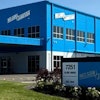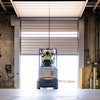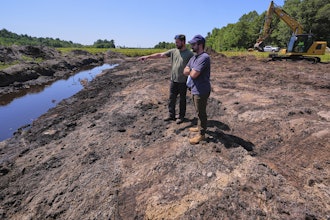
On conveyor systems in the food processing industry, some powdered and bulk solid materials are ignition sensitive in specific concentrations (i.e.- grains, sugar, creamer, etc.), particularly when exposed to static electricity discharge. A key point of concern is conveyor system connection points such as inlets, outlets, and storage bins. Here, the concentration of dust can become sufficiently high for a deflagration to occur with accidental exposure to an ignition source, such as static electricity, a spark, flame, or even high heat or friction.
So, the characteristics of the material conveyed and the type of conveyor along with its associated component parts and connection points should be considered in the system’s design to avoid a serious risk of dust combustion and explosion. By carefully selecting and integrating the conveyor system and its components, food processors can minimize the risk of dust explosions while safely conveying materials in a hygienic and energy-efficient manner.
“When conveying powders, understanding the requirements is critical because an explosion can injure people as well as destroy essential equipment, causing lengthy downtime. So, any conveyor system that handles such material must be designed and engineered to comply with all safety codes and have dust mitigation procedures in place,” says Gary Schliebs, a Process Engineer and Director of Plus One Percent…Engineered Solutions, a consulting firm that works in the food industry and globally markets food industry conveyor equipment.
Ignition Sensitivity
In food processing, a range of powder or bulk solid products can combust, including grains, flour, and sugar. One of the key factors in determining the risk for dust explosion is the product’s sensitivity to static electricity discharge in specific concentrations and fuel-to-air ratios, as well as its sensitivity to ignition in ambient air or processing conditions.
In general, static electricity can ignite a combustible dust cloud inside a food processing conveyor system if the minimum ignition energy of the dust is very low. Powder and dust conveyed at high velocity speeds through metal pipe or ducting can build up an electrostatic charge in the dust and potentially ignite. Because static charge can accumulate at different points in the system, the equipment should be fully grounded to earth so it does not discharge into the line.
In any food processing conveyor system, the dust explosion hazard is greater at connection points such as inlets, outlets, and ducts. Here, the powdered product is transferred into bins, hoppers, vessels and containers, potentially causing a dust cloud to form. For this reason, all connection points between conveyors and storage vessels should be bonded and grounded so no component is at a different static discharge potential from another, which could ignite the powder.
 Cablevey Conveyors
Cablevey Conveyors
Conventional open mechanical conveying systems, which utilize many moving parts, can become an ignition source. Bearings and out-of-alignment belt conveyors can be problem areas if they cause sparks or generate heat from friction.
Although some conveyor systems, such as pneumatic powered equipment, are enclosed, the use of high-velocity air can also potentially lead to the creation of a “dust cloud” inside the tube, as well as outside on its exit, although dust collectors and filter receivers can reduce this effect.
One solution is selecting a conveyor, such as a tubular drag conveyor, that conveys powdered material more slowly and gently. Tubular drag conveyors are enclosed systems that utilize a coated, flexible stainless-steel drag cable pulled through on a loop.
Because tubular cable conveyors do not suspend transported powders within high-velocity airstreams like pneumatic conveyors, this imparts “less energy” into the conveyance, which reduces the risk of a dust explosion. Unlike other conveyor systems, tubular cable conveyors operate on low horsepower with less heat and friction, using energy-efficient, variable-speed motors of less than 5 HP each.
“Compared to pneumatic systems, tubular cable conveyors use about a quarter of the energy to move product,” says Schliebs.
With tubular cable conveyors, solid circular discs (flights) are attached to a cable, which pushes the product at low speed through the tube without the use of air, reducing the potential for dust cloud formation and preserving product integrity. The systems can convey up to 2000 cubic feet per hour (56m3/hr.) of powders, granules, etc. with numerous layouts using multiple inlets and outlets.
“Tubular conveyors generate minimal dust due to the gentle, low velocity, so there is often no requirement for a dust handling system at the end, such as a bag station used to filter and clean the air,” adds Schliebs.
Without high-speed contact or scraping, the lower speed, lower energy motors of tubular drag conveyors also reduce sparking risk. In addition, the slower velocity reduces any friction and heat generated to well below an ignition point, limiting it about 10 to 20 °F above ambient temperature.
Preventing Powder Escape
When it comes to minimizing the risk of dust explosion, another challenge is preventing loose powder from escaping into the surrounding environment where it can accumulate and present a combustion hazard when exposed to a spark, flame, high heat, or static electricity.
For this reason, it can be a disadvantage to use open conveyors, such as bucket elevators or flat-belt conveyors.
“Bucket elevator drop zones where the bucket is tipped, or product goes down a chute will always generate dust at those points. Anywhere product enters or exits a conveyor belt also tends to create dust,” says Schliebs.
With pneumatic conveyors, since the air is usually above or below atmospheric pressure, this means powders can escape if there is an unexpected breach in the equipment or ducting.
“When powdery product is mixed with air under pressure, it can become a greater combustion hazard, particularly if you get a line break and it discharges out of the system,” says Schliebs. “Once, I witnessed a situation where a coupling came loose [in a pneumatic conveyor line] and it blew powder into the factory. Fortunately, there was no dust combustion, but the integrity of the whole system is paramount, so connections cannot be loose in pressurized systems.”
Minimizing Dust Accumulation
According to Schliebs, when it comes to minimizing the risk of dust explosions in food processing, even gentler enclosed tubular conveyor systems are not all the same given the two options: chain or cable.
For example, with tubular drag chain conveyors, the entire chain is directly immersed within the powders conveyed so dust and food particles can remain trapped after cleaning. With tubular cable conveyors, the cable has about 80% less area exposed than the surface area of the chain. Further, the cable is nylon sealed, preventing debris and dust accumulation within the cable strands.
Another way to mitigate dust accumulation is through sufficient cleaning to remove any potential powdered debris between batches. For this, Schliebs says tubular cable conveyor systems typically offer more options for dry and wet tube cleaning to remove accumulations of dust and food residue. These include brush boxes, urethane wipers, air knives, in-line sponges, in-line bristle brushes and multi-step, fully automated CIP wet cleaning.
To take advantage of these options, he often recommends tubular cable conveyors from Oskaloosa, Iowa based Cablevey Conveyors, a premium, specialty material moving, mechanical conveyor company. The company has designed, engineered, and serviced enclosed cable and disc tube conveyors for almost 50 years, and is in more than 66 countries
With Cablevey Conveyors, the tubular drag cable conveyor is engineered in conformance with EHEDG (European Hygienic Engineering and Design Group) hygienic standards, so that it is completely free of crevices, ledges and dead spots where dust and food particles can reside. Surfaces are designed to be convex, rounded or inclined to 45 degrees to prevent powder and dust residue.
The Final Word
Given the variety of conveyor choices and powdered ingredients that must be conveyed during processing, the potential risks warrant a careful examination of the available equipment options and system design in consultation with experts.
Systems that eliminate potential ignition sources, convey material with less force, and otherwise reduce the risk of dust explosion can help food processors protect their employees, production, and the brand.
Del Williams is a technical writer based in Torrance, CA.























